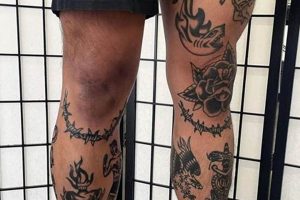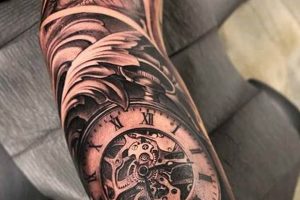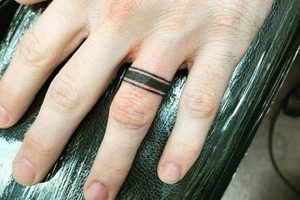Floral motifs, particularly roses, have long been popular tattoo choices, transcending traditional gender associations. A rose design offers numerous possibilities for masculine expression, incorporating elements such as thorns, skulls, daggers, or geometric patterns. Examples include a single black rose for remembrance, a vibrant full-bloom rose with a clock face for capturing a significant moment, or a tribal-style rose intertwined with a dragon for conveying strength and resilience. The diversity in style and symbolism allows for highly personalized designs reflecting individual stories and aesthetics.
The enduring appeal of rose tattoos stems from the rich symbolism attached to this flower. Historically, roses have represented love, passion, beauty, and even secrecy, making them a powerful symbol across cultures. In contemporary tattooing, these traditional meanings are often adapted and expanded upon. A rose can signify a range of emotions, experiences, or personal values, from honoring loved ones to marking milestones or embodying personal philosophies. This flexibility and depth of meaning contribute significantly to the enduring popularity of rose-themed ink among men.
Exploring the various styles and symbolic interpretations available provides a framework for choosing a design that resonates with individual preferences. Considerations include size, placement, color palette, and accompanying elements that further personalize the artwork. Subsequent sections will delve into specific styles such as traditional American, neo-traditional, blackwork, and geometric rose designs, offering a comprehensive overview of diverse options and their unique aesthetic qualities.
Tips for Choosing a Rose Tattoo
Careful consideration of several factors ensures a tattoo design aligns with individual preferences and desired symbolism. These tips offer guidance for selecting a rose tattoo that remains meaningful and aesthetically pleasing for years to come.
Tip 1: Research Symbolism: Rose color and accompanying imagery carry specific meanings. Thorough research prevents misinterpretations and ensures the chosen design accurately reflects the intended message.
Tip 2: Consider Placement: Tattoo size and complexity should complement the chosen body area. Larger, more detailed designs suit larger areas like the back or chest, while smaller, simpler designs work well on the forearm or wrist.
Tip 3: Choose a Reputable Artist: A skilled artist possesses technical expertise and artistic vision crucial for executing a high-quality tattoo. Review portfolios and consult with potential artists to ensure stylistic compatibility.
Tip 4: Reflect on Personal Style: Tattoo styles range from traditional to modern, realistic to abstract. Selecting a style that resonates with personal aesthetics ensures a cohesive and satisfying result.
Tip 5: Plan for Aftercare: Proper aftercare is essential for preserving the vibrancy and longevity of a tattoo. Follow artist instructions diligently to promote healing and prevent complications.
Tip 6: Don’t Rush the Decision: Tattoos are permanent. Taking ample time to research, conceptualize, and refine the design ensures a well-considered and cherished piece of body art.
Tip 7: Explore Different Styles: Consider various artistic approaches like traditional American, neo-traditional, blackwork, or watercolor to find a style that effectively conveys the desired aesthetic and symbolism.
By carefully considering these aspects, individuals can select a rose tattoo that embodies personal style, carries intended meaning, and remains a source of personal satisfaction for years to come.
Implementing these tips empowers informed decision-making, resulting in a tattoo that serves as a powerful form of self-expression.
1. Placement
Placement significantly influences the visual impact and symbolic meaning of rose tattoos for men. Careful consideration of body contours and desired visibility plays a crucial role in the overall design. A prominent placement, such as the forearm or bicep, may showcase a bold statement piece, while a more discreet location, like the ribcage or back, might hold deeper personal significance. The size and complexity of the design also factor into placement decisions. Intricate, large-scale designs often suit larger areas like the chest or back, allowing for detailed artistry. Smaller, simpler designs may be better suited for areas like the wrist or ankle, maintaining clarity and impact.
Practical considerations further influence placement choices. Areas frequently exposed to sunlight may experience faster ink fading, while areas subject to friction might require more touch-ups. For individuals in professions with dress code restrictions, discreet placement allows for personal expression while maintaining professionalism. For example, a full sleeve of roses conveys a different message than a small rose behind the ear. Placement choices can also complement existing tattoos, creating a cohesive and balanced overall aesthetic.
Strategic placement maximizes the impact of a rose tattoo, ensuring the design harmonizes with the body’s natural lines and effectively communicates the intended message. Understanding the interplay between placement, design, and personal context allows for informed decisions, resulting in a tattoo that resonates both visually and symbolically.
2. Color Symbolism
Color symbolism plays a crucial role in conveying meaning and emotion in rose tattoos. Color choices significantly impact the overall message of the design, adding layers of complexity and personalization. Specific colors evoke distinct associations, allowing individuals to express specific sentiments or commemorate particular experiences. For instance, a red rose traditionally signifies passion and romantic love, while a black rose often represents loss, remembrance, or rebellion. Yellow roses convey joy and friendship, whereas white roses symbolize purity and innocence.
Beyond traditional interpretations, color choices can also reflect personal experiences and individual meanings. A blue rose, though not found in nature, might represent the unattainable or a mystical connection. Combinations of colors further expand the range of symbolic expression. A red and black rose might signify the duality of love and loss, or the interplay of passion and danger. Understanding these symbolic associations allows for careful selection of color palettes that resonate with personal narratives and intended messages. Practical applications include choosing a color that complements skin tone and ensures visual impact. Darker skin tones may benefit from bolder colors, while lighter skin tones might suit softer shades.
Careful consideration of color symbolism adds depth and complexity to rose tattoo designs. Selecting colors aligned with intended meaning and personal aesthetics elevates the tattoo from a decorative element to a powerful expression of personal narrative and symbolic significance. This understanding facilitates informed decisions, resulting in a tattoo that resonates both visually and emotionally, carrying lasting personal meaning.
3. Design Style
Design style significantly impacts the aesthetic and symbolic expression of rose tattoos for men. Choosing a specific style influences the overall visual impact, conveying distinct messages and reflecting individual preferences. Styles range from traditional American, with bold lines and vibrant colors, to realistic depictions capturing intricate botanical details. Neo-traditional styles blend classic imagery with modern artistic sensibilities, while blackwork emphasizes stark contrast and graphic elements. Geometric designs incorporate precise lines and shapes, creating a modern and abstract interpretation of the rose motif. The chosen style should align with the intended symbolism and personal aesthetic. A traditional American rose might convey a classic and timeless message, while a geometric design could represent a more modern and abstract interpretation.
Specific design choices within a chosen style further personalize the tattoo. Incorporating elements like thorns, skulls, or daggers adds layers of symbolic meaning. Thorns can represent protection or resilience, while skulls symbolize mortality or remembrance. Daggers might convey danger or defiance. These additions create a unique narrative and enhance the visual impact. For example, a traditional American rose with a dagger piercing through it might represent overcoming adversity. A realistic black and grey rose with delicate shading could evoke a sense of melancholic beauty. Understanding the nuances of different design styles allows for informed choices that align with individual preferences and intended messages.
Careful consideration of design style ensures a cohesive and impactful tattoo. Selecting a style that resonates with personal aesthetics and symbolic intentions results in a piece of body art that holds lasting meaning and visual appeal. This understanding allows individuals to effectively communicate personal narratives and create a powerful form of self-expression through thoughtfully chosen design elements.
4. Incorporating Elements
Incorporating additional elements expands the symbolic depth and visual interest of rose tattoos for men. These additions create personalized narratives and transform a simple floral design into a complex piece of storytelling. Elements range from objects like skulls, daggers, clocks, and compasses to animals like snakes, wolves, or swallows. Each element carries its own symbolic weight, enhancing the overall meaning of the rose design. A skull combined with a rose might represent the duality of life and death or the acceptance of mortality. A dagger piercing a rose could symbolize betrayal, heartbreak, or overcoming adversity. Clocks often represent the passage of time or a significant moment, while compasses symbolize guidance and direction. Animal additions further personalize the design; snakes can represent transformation or temptation, wolves symbolize loyalty or guardianship, and swallows traditionally represent freedom or safe passage. Combining these elements with a rose creates a powerful visual metaphor, reflecting personal values, experiences, and beliefs.
The placement and style of incorporated elements further influence the tattoo’s narrative. A skull positioned beneath a blooming rose might suggest triumph over death, while a skull entwined with the rose’s thorns could represent danger or a darker symbolism. Similarly, the style of the incorporated element should harmonize with the overall design. A realistic rendering of a wolf might pair well with a similarly realistic rose, while a geometric wolf design complements a geometric rose. The scale and detail of incorporated elements also impact the visual balance. Smaller, simpler elements may enhance a minimalist rose design, while larger, more intricate additions can create a focal point in a more complex piece. Consideration of these factors allows for seamless integration of elements, enhancing both the aesthetic and narrative aspects of the tattoo.
Thoughtful incorporation of elements elevates rose tattoos from simple floral motifs to powerful symbols of personal narrative. These additions allow individuals to express complex emotions, commemorate significant experiences, and showcase deeply held values. Understanding the symbolic interplay between elements and the core rose imagery allows for the creation of truly unique and meaningful tattoos that resonate on both visual and emotional levels. This understanding provides a framework for informed design choices, resulting in a tattoo that serves as a lasting testament to personal identity and self-expression.
5. Size and Detail
Size and detail are crucial considerations in rose tattoo design, impacting both visual impact and practicality. Appropriate scaling ensures the intended design elements remain clear and legible, while the level of detail influences the overall aesthetic and symbolic depth. Careful consideration of these factors ensures a harmonious balance between artistic vision and the physical constraints of the chosen placement.
- Scale and Placement:
Scale must complement the chosen body area. A large, intricate rose design requires ample space, such as the back, chest, or thigh. Smaller, simpler designs are better suited for areas like the wrist, forearm, or ankle. Disproportionately large designs on small areas can appear cluttered and lose clarity, while small designs on large areas might appear insignificant. Placement also influences visibility and the potential for incorporating additional elements.
- Detail and Style:
The level of detail directly relates to the chosen style. Realistic rose tattoos demand intricate shading and fine lines to capture botanical accuracy. Simpler styles, like traditional American or geometric designs, utilize bolder lines and less shading. The desired level of detail should align with the chosen style and the artist’s skillset. Overly detailed designs can become muddled over time if not executed precisely, while simplistic designs benefit from clean lines and strategic placement.
- Impact of Size on Meaning:
Size can influence the perceived symbolism of a rose tattoo. Larger designs often convey bolder statements, representing significant life events or deeply held beliefs. Smaller, more discreet tattoos might hold personal meaning, serving as intimate reminders or subtle expressions of personality. The size chosen should align with the intended message and the individual’s comfort level with visible body art.
- Longevity and Detail:
Intricate details can fade or blur over time, especially in areas exposed to sunlight or friction. Larger designs generally hold detail better than smaller designs due to the greater surface area. Proper aftercare and touch-ups are essential for maintaining the clarity and vibrancy of detailed tattoos, regardless of size. Choosing a reputable artist skilled in fine line work and shading is crucial for ensuring the longevity of intricate designs.
Careful consideration of size and detail ensures a rose tattoo remains visually appealing and symbolically resonant for years to come. Balancing these factors with individual preferences, placement limitations, and artistic style results in a well-executed and meaningful piece of body art. This thoughtful approach allows for a cohesive design that effectively communicates personal narratives and aesthetic preferences.
Frequently Asked Questions
This section addresses common inquiries regarding rose tattoos for men, providing factual information and dispelling potential misconceptions.
Question 1: Do rose tattoos hold the same symbolic meaning for men as they do for women?
While traditional associations of roses with femininity exist, symbolic interpretations often transcend gender. Rose tattoos for men can represent a range of meanings, from love and passion to remembrance and resilience. The specific meaning often depends on design elements, color choices, and personal context.
Question 2: Are certain rose colors more appropriate for men than others?
Color symbolism, while culturally influenced, remains open to individual interpretation. While red roses are often associated with romantic love, darker shades like black or deep crimson can represent strength, remembrance, or overcoming adversity. Ultimately, color choice depends on personal preference and intended meaning.
Question 3: How does placement affect the masculinity of a rose tattoo?
Placement does not inherently affect the masculinity of a rose tattoo. Placement choices often relate to visibility preferences, body contours, and the size of the design. Areas like the forearm, bicep, or chest offer prominent display, while the back, ribcage, or calf provide more discreet options. The design itself, rather than placement, contributes most significantly to perceived masculinity.
Question 4: What design elements can enhance the masculine aesthetic of a rose tattoo?
Incorporating elements like skulls, daggers, geometric patterns, or tribal designs can enhance the perceived masculinity of a rose tattoo. These additions create visual complexity and add layers of symbolic meaning, personalizing the design and aligning it with individual preferences.
Question 5: How painful are rose tattoos, and how long do they take to heal?
Pain levels vary depending on individual pain tolerance, placement, size, and complexity of the design. Generally, areas with more muscle and fat tissue experience less pain than areas with thinner skin or closer proximity to bone. Healing typically takes several weeks, requiring diligent aftercare to prevent infection and ensure optimal color retention.
Question 6: What should one consider when choosing a tattoo artist for a rose design?
Selecting a reputable artist with experience in the desired style is crucial. Reviewing portfolios, seeking recommendations, and consulting with potential artists ensures stylistic compatibility and technical expertise. A skilled artist guides design choices, ensuring the final tattoo aligns with individual preferences and desired symbolism.
Careful consideration of these factors empowers informed decision-making, resulting in a rose tattoo that holds lasting personal meaning and aesthetic value.
This concludes the frequently asked questions section. Further exploration of specific design styles and symbolic interpretations follows.
Rose Tattoo Ideas for Men
Exploration of rose tattoo designs for men reveals a diverse range of stylistic interpretations and symbolic meanings. Placement, color symbolism, design style, incorporated elements, and size contribute to the overall aesthetic and narrative of the tattoo. Careful consideration of these factors allows for personalized designs that resonate with individual preferences and effectively communicate intended messages. From traditional American imagery to minimalist geometric representations, the adaptability of the rose motif allows for versatile artistic expression.
Ultimately, a rose tattoo serves as a powerful form of self-expression, reflecting personal experiences, values, and aspirations. Thoughtful design choices ensure a lasting piece of body art that carries deep personal significance and remains a source of individual pride. The enduring appeal of the rose in tattoo art underscores its timeless symbolism and capacity for conveying complex human emotions and narratives.







